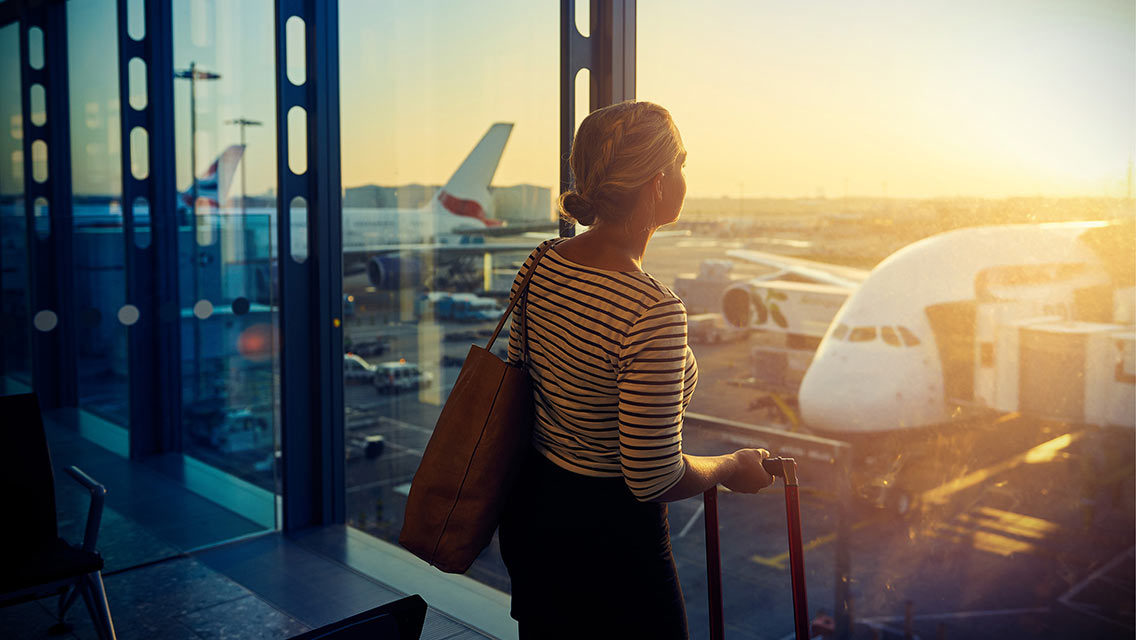Explore this article:
1) Fear of Flying ⋅ 2) Motion Sickness ⋅ 3) Jet Lag ⋅ 4) Constipation ⋅ 5) Prevent Getting Sick ⋅ 6) Overindulgence ⋅ Snacks to Pack
Adventure! Indulgence! A break from routine! All these things can make travel a delight. But they can also take a toll on our systems.
“Even if it’s for pleasure, travel is inherently stressful,” notes integrative psychiatrist Henry Emmons, MD, author of The Chemistry of Joy. “There’s just a lot going on.”
We may not have access to the foods and resources we rely on to keep us feeling great at home. And with the excitement of novelty also comes greater exposure to physiological and psychological stressors.
Though many of us consider these discomforts to be the price of travel, there are some simple nutrition- and lifestyle-based tricks that can keep you feeling steady and strong.
These are some strategies to help you conquer the most common travel woes.
1) Fear of Flying
For some, boarding a plane can bring on a racing heart, shallow breathing, clammy hands, a roiled gut, and clouded thinking. “It’s basically a miniature panic attack,” says Emmons. “Your body is in fight-or-flight mode, with too much adrenaline. You can only talk yourself out of that so much.”
But you have other options. Starting about a week before your trip, consider supplementing with magnesium, a calming mineral most of us are deficient in, suggests nutritionist Samantha McKinney, RD, CPT, Life Time’s national program manager for nutrition, metabolism, and weight loss. (She recommends magnesium glycinate or malate.)
Emphasizing protein and fat in your meals and midflight snacks can help you avoid blood-sugar swings that increase anxiety too.
“When you’re anxious, the body releases cortisol, which can spike blood sugar, so you’re already primed for those glucose swings,” McKinney explains. She recommends opting for nuts, seeds, cheese, or hard-boiled eggs instead of starchy or sugary foods.
Calming supplements such as cannabidiol (CBD), passionflower, kava, or L-theanine — particularly in the form of a fast-acting liquid tincture — can also help, says Emmons. Rescue Remedy, a blend of five relaxing flower essences, is another travel-friendly option. Any of these can be taken before a flight or for on-the-spot relief.
Finally, breathing exercises are an excellent way to get grounded — even in the air. “If your breathing slows, it sends a signal to the sympathetic nervous system that it can stand down,” explains Emmons.
He suggests:
- Inhaling to a count of four.
- Holding the breath for a count of two.
- Then exhaling to a count of seven.
“The counting is another way of distracting your mind,” he notes. (Explore these other breathing exercises.)
2) Motion Sickness
When there’s a difference between what you’re seeing (movement) and what you’re feeling (sitting still), motion sickness can occur. “The body uses different mechanisms to make sense of your equilibrium and balance,” explains McKinney. “If there’s a mismatch between the visual and inner-ear inputs that help you know where you are in space, your brain might have a hard time processing.”
Emmons notes that keeping blood-sugar levels stable can mitigate motion sickness. “Eat moderate-size snacks with some protein and fat relatively frequently,” he suggests. Think carrot sticks and hummus or a high-protein granola bar. “You want something with some fiber that’s not quickly digested.”
Ginger is another time-tested tool for calming nausea, notes Sara Jean Barrett, ND. She likes Gin Gins, individually wrapped ginger chews that are easy to toss in a bag or a pocket.
A whiff or two of peppermint oil can help settle an upset stomach as well. “An advantage of aromatherapy is that it gets into your body immediately,” says Emmons. “Anything you ingest will have a time lag.”
Homeopathic remedies such as tabacum and nux vomica can be good options for those who are familiar with the specific qualities of their motion sickness. “Tabacum is good if being warm makes the nausea worse, and nux vomica is for people who feel more chilly,” explains Barrett.
These remedies are typically taken in tablets or small pellets that dissolve under the tongue.
Keeping your eyes fixed on the horizon can be helpful. Barrett adds that some people find additional relief from acupressure bracelets that put pressure on the P6, or Nei-Guan, acupressure point (about three finger-widths from the base of your palm on your inner wrist). “You can also alternate gently pressing that spot first on one wrist and then the other.”
3) Jet Lag
Anyone who has endured a restless night before an early flight knows that travel can affect sleep even before you leave home. Add in changing time zones, stress, and unfamiliar environments, and the challenges to sleep only mount.
When traveling across time zones, Barrett says, try to adapt as quickly as possible to the clock time at your destination. “Eat meals aligned with where you are,” she suggests. “If it’s morning when you land, have breakfast.” And make sure to expose yourself to morning sunlight, one of the best tools for adjusting your internal clock.
Keep your last meal of the day lighter, and eat earlier. “If your body is digesting food at night, you won’t sleep as well,” says Emmons.
Including a small amount (about a cupped handful) of carbs with a protein-rich dinner can support serotonin and melatonin production, McKinney adds. Adding some sweet potato or quinoa to a meal “can be helpful to support overall sleepiness.”
Taking 1 to 3 mg of melatonin about 30 minutes before bed can help reset your circadian rhythm. (Higher doses aren’t more effective, says Barrett; they just cause a hangover effect the next day.)
“If you’re traveling across many time zones, use melatonin for several nights, not just the first,” she suggests. Chewable tablets work, or try sublingual melatonin, which is absorbed even more quickly.
A tincture of passionflower or a mixture of the cannabinoids CBD (cannabidiol) and CBN (cannabinol) may calm a busy mind at bedtime. Sleep-promoting tea packets containing valerian root, chamomile, hops, or passionflower are easy to throw in your bag and prepare in a hotel room.
Remember that even when you’re traveling within the same time zone, altered routines and environments can present challenges. “The circadian rhythm is tied to when we exercise and eat food each day,” notes McKinney. “When that routine is shifted from our usual schedule, it can be disruptive to sleep.”
4) Constipation
The same factors that take a toll on our sleep — altered routines, higher stress, new environments — can also do a number on elimination. “People are off their daily rhythm when traveling, and they don’t have as much private time,” notes Emmons. “For a lot of people, the GI system kind of shuts down.”
Eating on the run is also less conducive to mindful food choices. We may get less fiber than usual or find ourselves scarfing meals in a rush. “All these things compound,” says Barrett.
Staying hydrated is a simple and important piece of the digestion puzzle. “Particularly when you fly, you want to stay hydrated,” she says; the recycled air on planes can dehydrate you quickly.
Always pack an empty water bottle in your carry-on, ideally with a filter, and fill it once you’re through security. Keep it handy on your flight and take regular sips. Bring a reusable straw if you prefer to stay masked while you drink.
Getting enough fiber is also important. “Bring your own high-fiber snacks or a meal packed at home,” suggests Barrett. Energy balls made with nut butter, chia seeds, oats, and protein powder are easy to prep in advance.
Carrot sticks with hummus make a well-balanced, portable snack. And prunes are a reliable choice for keeping things moving.
When grabbing meals on the go, emphasize veggies, fruits (especially berries), and beans, says McKinney. “Be diligent about getting that fiber in.”
Magnesium has a role to play here too. Not only does it help with sleep and stress, but it’s also a key player in keeping us regular. “Magnesium is a good supplement for most people to take regularly — not just when you’re traveling,” McKinney says.
Emmons also packs capsules of Triphala, an Ayurvedic herbal remedy that supports gut motility. “It won’t cure constipation, but it can help prevent it,” he notes. “Start it about a week before your trip rather than waiting until you’re traveling.”
In addition to keeping you calm during a flight or a long drive, deep-breathing exercises can help stimulate the vagus nerve, which is critical for healthy digestion.
When you reach your destination, take a few minutes to do some gentle yoga poses. “Anything that twists your midsection will be helpful,” says Barrett. “Squeezing, twisting, and big belly breaths can help keep things moving.” (Try these three gentle twisted yoga moves to start.)
5) Getting Sick
Nothing puts a damper on vacation like getting sick, and with the stresses of travel and the increased exposure to bugs, the risk of coming down with something rises. “Stress will tank our immune response,” says Barrett. “Plus, when we travel, we eat more treats and drink more alcohol, which will also impact the immune system.”
To boost your defenses, fortify your vitamin D levels and start taking immune-supportive mushrooms, such as maitake and reishi, a few days before you leave. “There are little packets you can mix with coffee, or capsules you can also bring with you,” suggests Barrett.
Food choices matter. “Sugary snacks and sweetened lattes are not supportive of healthy immune-system function,” says McKinney. She suggests getting fresh veggies and fruits that deliver plenty of vitamin C, such as bell peppers, strawberries, and citrus.
Emmons likes the convenience of vitamin C packets for travel, but McKinney cautions that they often contain a lot of added sugar. She prefers vitamin C capsules — 1 to 2 grams twice daily while traveling; some research suggests that combining them with zinc and quercetin may disrupt viral replication. For the best protection, begin taking them a few days before travel.
McKinney also uses N-acetylcysteine, a precursor to glutathione — an immune-supportive antioxidant that gets depleted by alcohol intake and stress. Some people find that teas containing elderberry, licorice root, echinacea, curcumin, or astragalus can also bolster defenses on the go.
6) Overindulgence
Travel almost demands that we abandon some of our usual healthy disciplines. We might overdo it with coffee or alcohol, eat foods that disagree with us, or skimp on sleep — and that’s OK. “Let yourself overindulge once in a while,” says Emmons. “Vacations are good for that!”
There’s also no need to suffer unduly from enjoying yourself. It’s relatively easy to offset the price of celebratory consumption — stomach upset, headache, bloat, fatigue, and hangovers — with a few tweaks.
“Try not to overindulge in food or alcohol too close to bedtime,” advises Emmons. Staying hydrated can also forestall a lot of problems, including hangovers and indigestion. “Drink a big glass of water about an hour before a big meal,” he suggests.
Augmenting your natural digestive enzymes with supplements can help prevent bloat, gas, and an irritated stomach. For best results, says McKinney, “take digestive enzymes with meals instead of after.”
Eating out three meals a day can be tough on the system, notes Barrett. If you have known food sensitivities, she recommends using enzymes at least once a day while traveling. An enzyme called Aspergillus niger-derived prolyl endoprotease can help break down gluten.
Those sensitive to dairy might benefit from taking lactase. Others can opt for a broad-spectrum enzyme to help with their sensitivities.
There are other easy techniques. “Having gum to chew after meals can help with slow or sluggish digestion, and it’s easy to carry in your bag,” says Barrett. Chewing gum keeps saliva production going; this stimulates digestion by making the body think more food is coming, she explains.
Ginger chews and ginger or peppermint tea are other handy digestive aids. And simply going for a nice after-dinner walk can pay dividends, McKinney notes. “Light movement helps the digestive tract.”
If you wake up regretting your food or beverage choices from the night before, take heart. Bitter foods, such as arugula and Brussels sprouts, and tart, stimulating seasonings, like apple cider vinegar and lemon juice, can help enhance digestion and support natural digestive enzymes.
“Throw some arugula in your eggs, or take bitters as a tonic,” advises McKinney. Or add a lemon slice to a big glass of water; lemon juice helps stimulate liver function.
Homeopathic remedies include nux vomica, which is good for nausea, and lycopodium, which can mitigate distention and gas pain.
And while indulgence is a healthy and welcome part of a vacation, try to take a balanced approach, says McKinney. “When you’re traveling for pleasure, it’s supposed to be enjoyable. Really have that full experience in your head of how you’re going to feel in the morning.”
Snacks to Pack
Bringing your own food is a good strategy when you’re not sure what will be available. These are some easy items to pack along with you.
On the plane:
|
On the road (with a cooler):
|
Visiting friends or family:
|
This article has been updated and originally appeared as “Treat Your Travel Woes” in the November 2022 issue of Experience Life.






This Post Has 2 Comments
I will incorporate most of these tips in my upcoming trip to New Zealand. Many thanks.
I travel back and forth between Europe, where I live, and the US, where family is, several times a year. It’s been my goal to reduce the acclimation period. I’ve employed many of the items listed in your article. But, my two favorite tools for resetting in a new time zone that weren’t mentioned are a travel earthing mat and flotation (sensory deprivation). The last requires finding a float center in your area, but it pays off if you really want to adjust faster.